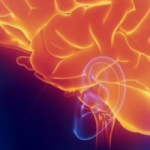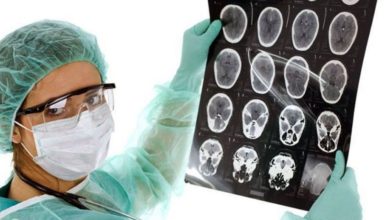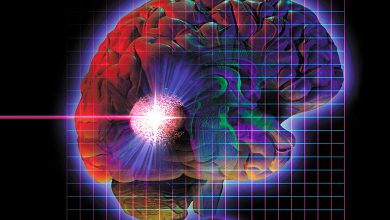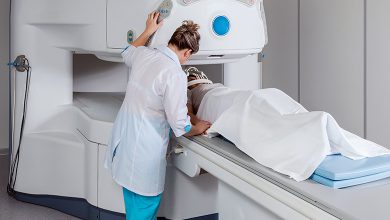Brain tumor symptoms
The content of the article
Symptoms when diagnosed with a brain tumor can usually be noticed at an early stage . The disease itself is significantly different from all other types of neoplasms. The main problem of diagnosis is the failure to find a brain tumor and therefore it is quite difficult to begin treatment in a timely manner. As a result, the chance of recovery is significantly hampered, and sometimes treatment becomes completely useless due to the development of stage 4 cancer.
The reasons why you should contact an oncology specialist are various symptoms. Currently, due to the active development of science and medicine, doctors can clearly identify which signs of a brain tumor indicate the presence of potential problems. This allows you to detect cancer in its early stages and get rid of it.
Development process and types of disease
All brain cancers form directly from brain cells. Their formation is associated with practically uncontrolled cell division.
The tumor itself greatly increases in size and spreads to all the brain tissues that are adjacent to it. Of course, tumors that are benign cannot metastasize to other organs, but are localized exclusively in the affected part of the brain. But due to the fact that the skull is small, this tumor develops and becomes cancerous.
It is customary to divide the disease according to two main criteria:
- Primary view. In this case, a brain tumor is formed directly from the tissues and meninges.
- Secondary view. A tumor is formed when metastatic cells exist in neighboring organs.
All cancer symptoms related to a brain tumor are usually divided based on the composition of the cells. There are more than 100 different types of this disease. They, in turn, are combined into 12 special categories.
The most common are:
- neuroepithelial, which are usually found in almost 2/3 of all patients. Formed from tissues in brain cells;
- meningiomas , which are formed under the influence of division of the lining of the brain;
- pituitary, which are formed from the process of cell division of the pituitary gland;
- the lesions are located outside the brain, which indicates the metastatic nature of the neoplasm;
- dysembryogenetic, which are formed during the process of incorrect cell division in other organs.
When not one, but several levels of differentiation are identified in a tumor, then the process of disease development is determined by the infected cells.
Main stages of tumor development
As already described above, any oncological disease, including a brain tumor, has several stages of its own development. All symptoms of cancer in the early stages can be characterized by the fact that infected cells are located within the boundaries of the tumor. With further development, the cells begin to spread to other organs.
By primary tumor we mean that the disease develops directly in the brain tissues and areas that are as close as possible. Characterized by the presence of certain mutations in cells. Deviations of this type are an important factor that contributes to the development of infected cells.
The main causes of brain tumors
Today, modern science cannot give a complete answer to the question of how exactly the human brain is structured and functions. As a result, in the past, the main causes of such tumors included various mechanical head injuries, smoking, and infectious diseases. However, there is no confirmation of this, and modern research rather refutes these speculations.
Symptoms of a brain tumor in adults, according to scientific data, mainly have the following prerequisites:
- poor heredity; an extremely serious factor is whether relatives have had cancer in the past;
- activities that are directly related to active and close contact with chemicals;
- radiation exposure of an ionizing nature, which greatly affects the body and dramatically increases the chances of cancer;
- age - the older the patient, the greater the likelihood of getting sick; the main risk group is over 45 years old;
- past medical history of immediate family members.
For all types of tumor diseases, all symptoms are divided into two fundamental types: general cerebral and focal.
General cerebral symptoms are quite typical for almost all types of cancer, while focal symptoms directly depend on the specific location of the tumor.
With brain tumors, symptoms are of two types: focal and cerebral. General cerebral are characteristic of all cases of brain cancer, while focal ones depend on the location of the tumor.
General cerebral symptoms include:
- Frequent and severe headaches that are no different from pain caused by other causes. Gradually it becomes impossible to relieve with any painkillers. In the morning they appear much stronger.
- Vomiting, which is different from nausea caused by gastrointestinal diseases. It does not bring any relief, is unsystematic in nature, and is not associated with meals.
- Severe levels of dizziness. It is also indistinguishable from dizziness caused by another reason.
- Problems related to vision. It gradually deteriorates and deteriorates.
- Seizures of an epileptic nature.
The most dangerous are focal symptoms, some of which may coincide with cerebral symptoms. This type of symptoms is very diverse, and their characteristics directly depend on the location of the tumor.
Among all the most common symptoms of a focal nature, it is customary to highlight:
- Impairment of the level of mobility of the limbs of the human body: either complete impairment or partial impairment can occur. Their sensitivity and susceptibility to external factors is also impaired.
- Various kinds of changes directly related to a person’s personal qualities. The usual character changes a lot. As a result, it may happen that a person who was hot-tempered and active in the past loses interest in everything, while a calm person, on the contrary, becomes overly aggressive and nervous. Poor decisions, impulsivity and other factors can look like signs of a brain tumor.
- Complete or partial loss of effective bladder control. Problems with the urination process.
- Intracranial pressure increases, and depending on the location of the tumor, pressure occurs on one or another part of the brain. Such symptoms often have a certain similarity with general cerebral ones.
- Severe dizziness occurs, gait stability is lost, and balance becomes much more difficult to maintain. Moreover, it is important that when these symptoms occur spontaneously and without reason, this can be the cause of a serious illness.
- Headaches of a severe nature, usually in the morning, are localized in the place where the tumor is located.
- Vomiting processes that occur with a sudden movement of the head. So, as in the case of general cerebral symptoms, it is completely unrelated to food. In the case of constant and severe nausea, accompanied by food rejection, severe dehydration of the body is possible, and the water-salt balance in the body is also disturbed. People usually take pills that block this.
Some other signs of a brain tumor in an adult:
- Problems with sensitivity at all levels: from tactile to temperature. The capabilities of the musculoskeletal system are impaired. Characteristic can be called paresis, which in the early stages is very rare and insignificant. Once the tumor and disease develop, they lead to complete paralysis of the limbs.
- In cases where the tumor is located close to the auditory nerve, a strong impact on it is possible. As a result, instead of full-fledged sounds, a person begins to hear noise, which is quite difficult to distinguish. As the disease progresses, hearing may be completely lost.
- In the case when the tumor, one way or another, affects the nerves responsible for vision, disorders associated with it occur. The ability to recognize written characters is lost; objects that are in motion lead to problems. If the tumor is too close to the eyes, almost complete loss of vision can occur.
- When the tumor is located in the areas of the brain responsible for language, whether spoken or written, the patient may experience a loss of these skills. Moreover, as in other cases, the situation is gradually worsening. The early stages of cancer are characterized by poorly understood speech and changes in handwriting. Further development of the disease leads to the complete loss of speaking functions, and subsequently written ones. Only he himself can understand what a person infected with a brain tumor says and writes.
Signs of a brain tumor of an autonomic nature may appear. Their peculiarity can be called an extremely high degree of fatigue of the human body. There is also a certain weakness, an inability to fully control one’s own body. Convulsions may occur. And when the midbrain and cerebellum are affected, all coordination is extremely disrupted. The simplest tests, such as determining the tip of the nose, become an insurmountable obstacle for a person. As the disease progresses, falls and complete loss of the slightest coordination are possible.
From a personal point of view, in addition to changes in character, a person in the last stages of cancer completely loses the sense of space and time; nothing exists for him.
How does a brain tumor manifest itself in the late stages of cancer?
Obviously, the signs that appear in a person if the disease develops to a late stage are different from those that doctors observe at the beginning.
The pressure that the tumor puts on the optic nerve leads to its complete death. As a result, spots appear before the eyes, then vision is partially lost, and then completely. Even with effective cancer treatment, vision cannot be restored.
Similar consequences await after compression of the auditory nerve, only hearing will be lost forever.
The second and more advanced stages of cancer include seizures, which occur in young people, among the signs of a brain tumor. All this should force the patient to see a specialist.
Different symptoms are observed in the case of adenomatous tumors. Large-scale hormonal disruptions occur.
If the brain tumor is located in the brain stem, serious disruptions in the functioning of respiratory activity may occur. The sense of smell deteriorates. However, it is worth noting that despite the fact that the signs of a brain tumor in adults can be frightening and very serious, capable of depriving a person of the opportunity to lead a full life, the tumor itself can be benign . However, the very presence of such a neoplasm may require very serious treatment, including surgical intervention.
In addition, a tumor located in the temporal lobe can lead to hallucinations, while a tumor in the occipital lobe leads to problems with color perception.
The process of diagnosing a brain tumor
It is important to note that the diagnosis of brain cancer is carried out at the present stage in the form of several different methods. The process itself is carried out in several successive stages.
First of all, you need to make an appointment with a neurologist. He will carry out a full examination and identify health abnormalities, if any. The specialist knows which symptoms of a brain tumor are most common.
This doctor examines the following reflexes:
- hearing level is determined;
- vision is checked;
- the degree of coordination is measured, etc.
The process of correctly analyzing the results that were obtained is very important. Problems that arise due to the development of a brain tumor lead to disruption of the normal functioning of these organs.
Next, an X-ray study and other steps are performed that are directly related to making the most correct diagnosis. The patient is required to undergo this procedure. In principle, absolutely any suspicion of cancer is checked in this way. It is not entirely correct to classify this study as a simple x-ray. It is more accurate and modern, and, as a rule, has the name computed tomography . The brain is scanned using X-rays from all possible sides.
After this, the results that were obtained are scanned on a computer and a complete picture of everything that happens inside the skull is formed. In some cases, the patient is given a special drug that accumulates in the tumor if it is present. This makes it possible to accurately determine healthy and diseased areas of the human brain.
Such a modern method as magnetic resonance imaging is also actively used. This method is based on the practical application of a magnetic field. The results obtained from the practical use of MRI have accurate data and an excellent picture of what is happening in the brain from the inside. Any tumor cannot hide from MRI. It is more effective than the CT scan described above.
A significant advantage of this type of study is also the fact that it can be carried out in relation to those people who are allergic to iodine, which is the basis for the substance administered during computed tomography. Of course, magnetic research also has certain disadvantages and contraindications. For example, people who are claustrophobic should not undergo this procedure because they end up in the scanner on their own and may experience increased fear as a result. In addition, magnetic examination has a negative effect on various versions of pacemakers.
If, based on the results of tomography, a person is diagnosed with a brain tumor and its main symptoms are diagnosed, he must be hospitalized in a special oncology hospital. This is done for the purpose of further research and maximum treatment.
You can also take additional tests. One type is called a spinal tap. In this case, a small amount of cerebrospinal fluid, a substance that is located directly in the human brain, is taken from the patient. It is taken under anesthesia. Next, a laboratory test is carried out, as a result of which a particular diagnosis is made.
There is also another interesting diagnostic method. Called angiography. In this case, a special dye is injected into the patient's blood and sent to the brain area. The dye colors all new growths and you can see them all on an x-ray.
In addition, craniography is used. This term refers to the definition of bone marrow changes, because cancer cells, as a rule, tend to accumulate calcium.
Please rate the article:





